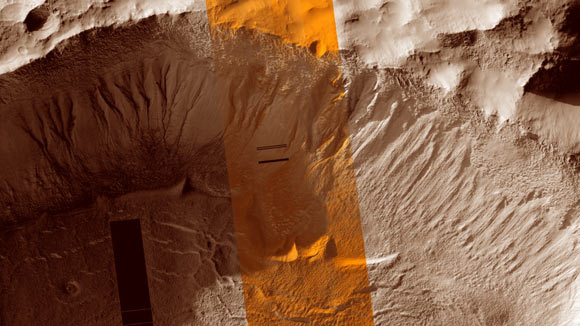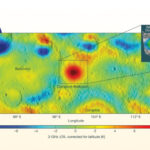Some steep slopes on Mars have gullies with morphologies suggesting that they were formed by a liquid. However, the planet’s current climate is not conducive to the melting of water ice at those locations, and mechanisms involving carbon dioxide ice do not explain the distribution of these features. In new research, planetary scientists from Brown University, Caltech, NASA and the University of California, Santa Cruz simulated how the Martian climate differed when its axis tilted by different amounts over the past few million years. At a tilt of 35 degrees, the ice caps partially melted, raising the atmospheric pressure, and there were higher summer temperatures; under these conditions, the atmospheric pressure at the gullies would be above the triple point of water, so it could melt to form a liquid.
This image from the High Resolution Imaging Science Experiment (HiRISE) camera on NASA’s Mars Reconnaissance Orbiter shows the Terra Sirenum region on Mars and its gullies. Image credit: NASA / JPL / University of Arizona.
Although the Martian gullies resemble similar water-carved formations on Earth, they mostly exist at elevations where liquid water is not expected under the planet’s current climate and atmospheric conditions.
It’s been suggested that sublimation of carbon dioxide ice could have formed these gullies.
However, the mechanism underlying this process is uncertain, as the process lacks an Earth analog and cannot fully explain the distribution of Mars’ gullies.
Another hypothesis suggests that small amounts of liquid water created the gullies during earlier climate conditions more conducive to the melting of water ice.
Furthermore, previous studies have shown that during periods of higher obliquity in Mars’ past, water ice could have accumulated in locations that now contain gullies.
“We know from a lot of our research and other people’s research that early on in Mars history, there was running water on the surface with valley networks and lakes,” said Brown University’s Professor Jim Head.
“But about 3 billion years ago, all of that liquid water was lost, and Mars became what we call a hyper-arid or polar desert.”
To better understand the role liquid water may have played in forming these features, Professor Head and colleagues used a 3D global circulation model of Mars to simulate how the planet’s climate differed when its axis tilted by varying amounts over the last million years.
They found that at 35-degree obliquity, locations of current gullies reached pressures of more than 612 pascals and ice surface temperatures likely surpassed 273 K (melting point of water ice).
As a result, melting ice could have stayed liquid during periods of high obliquity, carving gullies in the high-altitude areas where they are currently found.
“Our study shows that the global distribution of gullies is better explained by liquid water over the last million years,” said Caltech’s Dr. James Dickson.
“Water explains the elevation distribution of gullies in ways that carbon dioxide cannot.”
“This means that Mars has been able to create liquid water in enough volume to erode channels within the last million years, which is very recent on the scale of Mars geologic history.”
A paper describing this research was published June 29 in the journal Science.
_____
J.L. Dickson et al. 2023. Gullies on Mars could have formed by melting of water ice during periods of high obliquity. Science 380 (6652): 1363-1367; doi: 10.1126/science.abk2464




